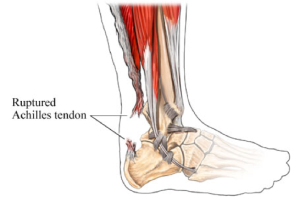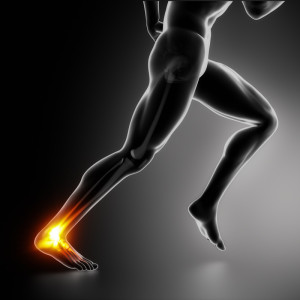One of the most common injury that athletes dread about once that painful twist in the ankle is felt in the middle of a game, for worst case scenario, is a ruptured achilles tendon. Any abrupt flexion of the foot may cause this, although it is also seen in middle aged and  elderly individuals, those who are taking fluoroquinolone antibiotics and trauma.
elderly individuals, those who are taking fluoroquinolone antibiotics and trauma.
The achilles tendon is located at the back of the leg and the foot. It represents the insertion of the gastrocnemius and the soleus, both calf muscles of the lower leg. It is a strong and thick tendon, surrounded by fascia and adipose tissue. It is one of the strongest tendons in the body that can normally handle load that is 3 times one’s body weight.
When a person sustains an achilles tendon tear, there is a snapping feeling in the lower calf accompanied by excruciating pain. Some people can still walk but running may not be possible as well as movements involving flexion of the foot. Any number of activities may lead to an Achilles tendon tear, which may include an auto accident, work injury or a sports injury.
 Swelling in the calf may also be observed. The history of the patient must also be taken into consideration especially when there has been a sudden increase in the level of intensity in training or physical activity.
Swelling in the calf may also be observed. The history of the patient must also be taken into consideration especially when there has been a sudden increase in the level of intensity in training or physical activity.
If there was a previous ruptures of the injured tendon, that must also be noted. Intake of anitbiotics and corticosteroid should also be identified as well. The area of the tendon that is mostly ruptured is the part slightly above the calcaneal attachment due to lack of blood vessels.
To further confirm that the patient has a ruptured achilles tendon, physical examination must be done by Arizona workers compensation specialist. The physician will check for the presence of tenderness, swelling and deformation.
Clinical testing can also be performed. This includes the hyperdorsiflexion test where the patient in a prone position is asked to flex the knees 90º with passive dorsiflexion of both feet. The degree of dorsiflexion between the injured and unaffected foot is observed.  Another test is the O’Brien needle test that includes insertion of the needle in the area where the achilles tendon meets the calcaneus. An achilles tendon rupture can be confirmed if the needle moves opposite to the tendon during flexion of the foot.
Another test is the O’Brien needle test that includes insertion of the needle in the area where the achilles tendon meets the calcaneus. An achilles tendon rupture can be confirmed if the needle moves opposite to the tendon during flexion of the foot.
Delaying the treatment can lead to worsening of the tear as it can see the tendon edges retract away from each other. Treatment may consist of conservative option with a cast, or a surgical option where the tendon is sutured back together. There are compelling reasons to do each, and the workers comp pain doctor in Phoenix will discuss both options with you.






Leave A Comment